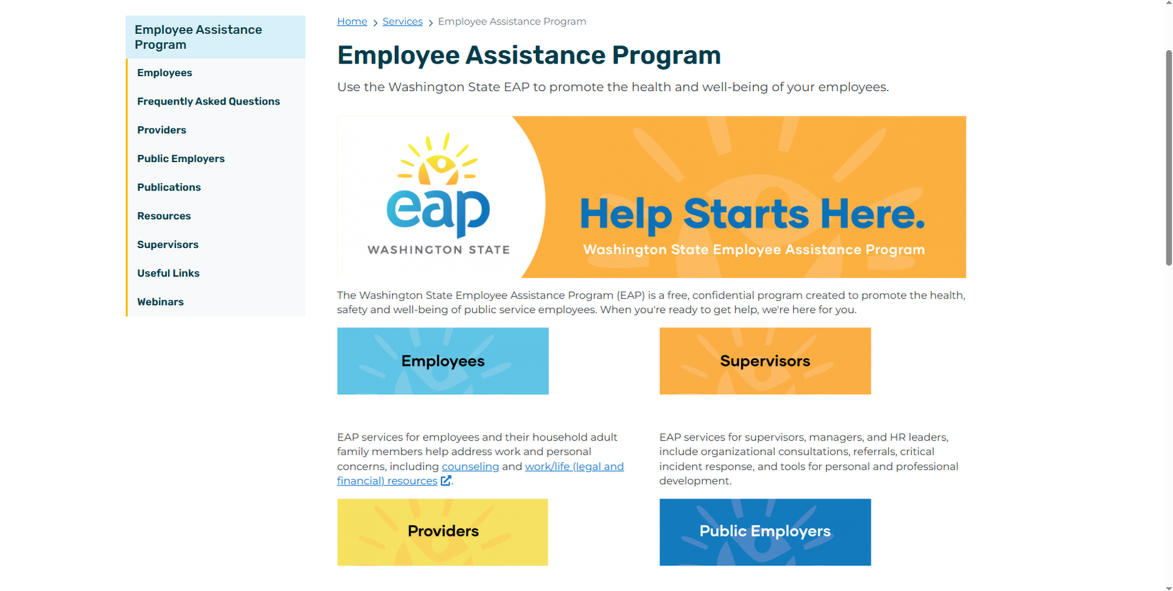Employee Assistance Program Website Redesign
This work was during my time as a UX Researcher Associate with design consultancy Anthro-Tech Inc.
The Washington State Employee Assistance Program (EAP) is a state-run program that provides access to a variety of free services and resources that “promote the health, safety, and well-being of public service employees across Washington state.” Currently, the program is managed under the Washington State Department of Enterprise Services (DES).
Before the redesign, the EAP pages were buried in the larger DES website. Content was hard to find organically and the section itself was confusing to navigate. The EAP and DES staff hoped a new website would give clearer, direct access and increase exposure to underutilized services.
I was one of two Researchers on a team that also included Operational Change Managers, Content Strategists, Designers, and Accessibility Specialists. Our main point of contact was the digital team at DES, with frequent input from the subject matter experts at EAP. This project was unique in that, due to timeline and budget constraints, the client took lead on the branding and interaction design, and some of the research. Our team took extra care and communication to ensure we were in alignment to account for this shift in responsibilities.
Landing page for the EAP on the DES website, before the redesign project.
Approach
The deeper goal of this project was to transform the EAP’s online presence. This required a mixed method approach to gain an understanding of what users and staff needed, and what EAP could provide.
Discovery Meetings
Our research began with meetings with the DES and EAP staff to get their perspective on the scope of the website, services, and users. We used a semi-structured format, with support from a Miro workspace. The highlights for me from these meetings were:
The variety and fluidity of users. In general, users could be grouped into distinct categories based on the type of services they were seeking but it wasn’t uncommon to have users that straddled those groupings. Additionally, sometimes people browsing online might coincidentally find the website because they were searching similar keywords. It was important to EAP that they could still in some way help visitors who didn’t qualify for EAP services.
Many services were underutilized, and EAP suspected that this was because people just didn’t know about them.
The potential mental state of users. Due to the nature of the services EAP provides, some users may come to the website in significant distress, which has a direct impact on how they are going to receive and process content. The most critical information and services need to be incredibly easy to find.
Tree Testing
Before the project started for us, the DES and EAP team ran a card sort with users. The response rate was lower than expected which presented a challenge for our team when we started working on the tree test. Without enough info from the card sort, we didn’t have initial signals to work from to start the new website structure. We and the content strategist decided to make do with whatever data was available and what we learned from our meetings with EAP. We drafted a best-attempt tentative IA, released the tree test into the wild, and just saw what happened. We found that the results were plenty informative enough to tweak the IA and make a foundational starting point for later testing:
Expanded understanding on the variety of users and how their approach to navigation changes depending on the scenario
Which scenarios users were consistently successful with across the board—these parts of the IA we shouldn’t change too much
Impacts of certain language and labels on navigation
Prototype Testing
During and after the previous research activities, the DES team designer was hard at work creating new branding and design for a prototype. At this point, the other researcher on the team was out of office so I was taking lead on coordinating and running the planning, recruitment, moderating, and analysis of the prototype testing.
It was especially important to me that the EAP staff’s lingering questions and concerns about the website were being properly addressed during the testing. Since the DES digital team was our main point of contact, there was risk of input falling through the cracks as it got passed down.
Recruitment was particularly challenging for this round of testing. I was limited on the number of participants we could recruit for the study so I had to be extra meticulous to make sure we got diversity across a number of factors including job role, demographics, disabilities, company type, etc.
All challenges aside, we were able to get a number of informative and actionable insights for the DES team to take forward to development.
Homepage of the new and current EAP website.

